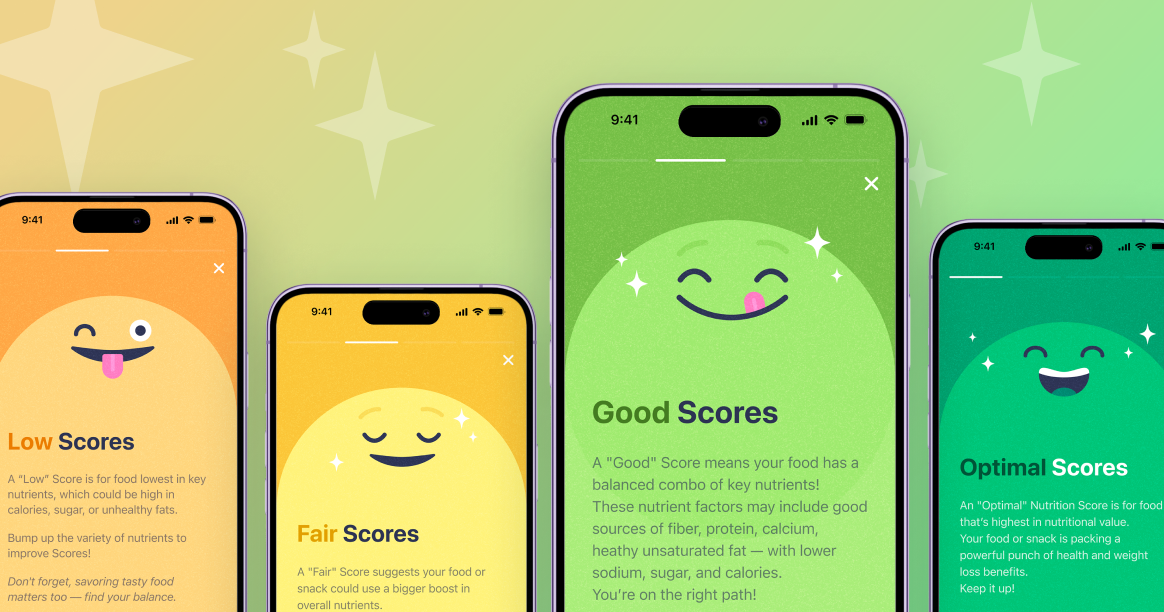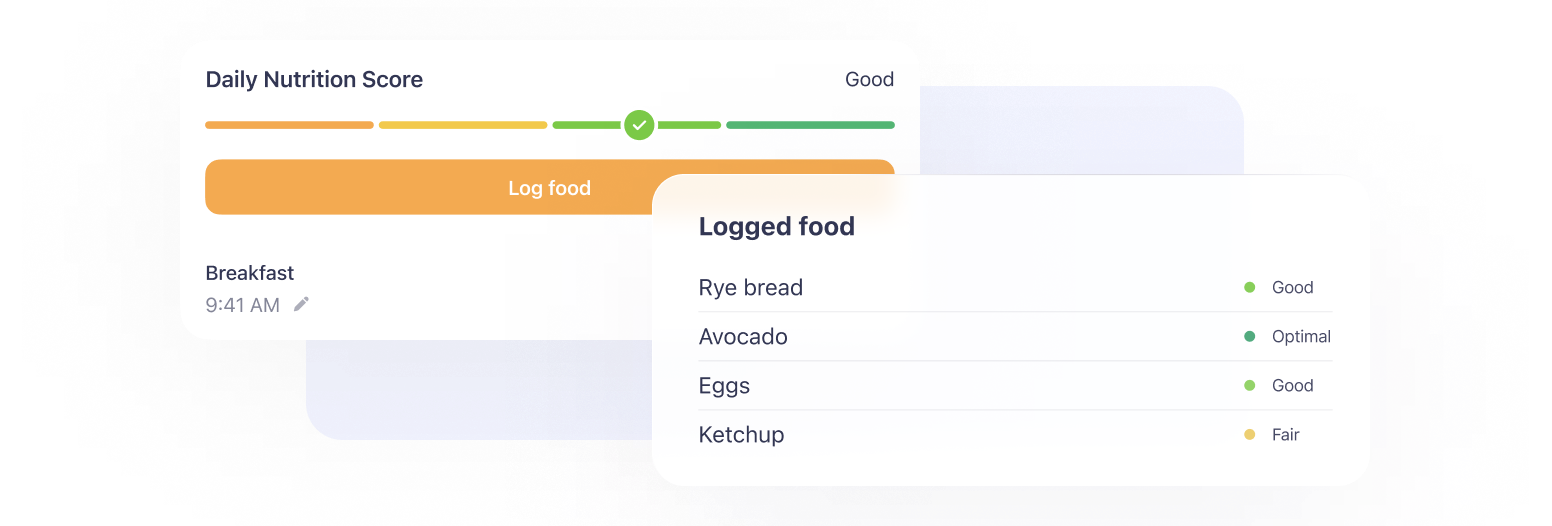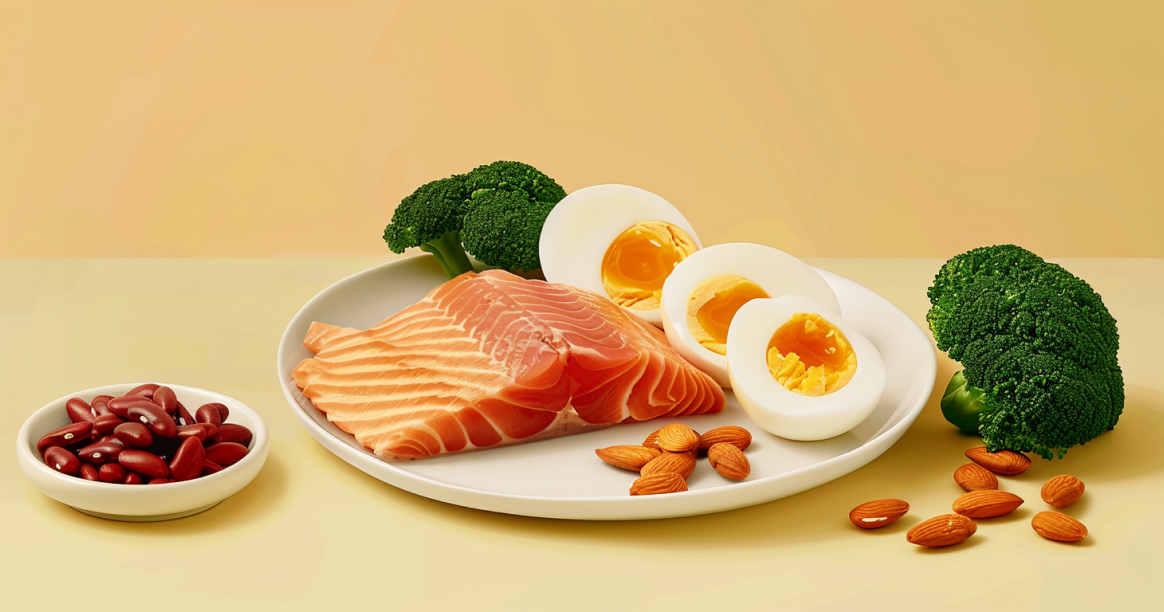5 Nutrition Scores updates to unlock more precision in your eating

What does the Simple app have in common with an elite athlete? Yup, an unwavering commitment to using data to push for constant improvement. (Though, at Simple, we’ve less of a need for energy gels.)
Your feedback fuels every improvement we make — and how we’ve improved Nutrition Scores is no different. We’re always listening to what you tell us about how you use the app and what you’d change. This is critical data for us. We put it into the mix alongside our expertise in tech, nutrition science, and coaching, and voila! Freshly-baked functionality that meets your needs and serves your goals, released on the regular.

Since Nutrition Scores launched last summer, we’ve scored over 28.2 million meals, and it has a 4.6 out of 5 average daily star rating (thank you!). So we know you’re loving it and can hand-on-heart promise that the underlying science has always been strong.
But now, it’s even better. Because nutrition science, AI technology, and your needs are always evolving, Nutrition Scores has to keep pace. Our recent improvements mean you’re even more equipped to pack your meals full of powerful nutrition that pushes you toward your goals.
What have we updated and why?
Nutrition Scores now:
- even more accurately reflects the nutrient content of foods you log;
- draws from a bigger food database; and
- scores your meals more constructively.
If you’re still wondering how we’ve made our already-accurate Nutrition Scores system even more precise, read on. We’re going behind the scenes so you can see for yourself.

#1 Changing how a meal gets an Optimal Score
Let’s start with the biggest change. Before, to score Optimal, a meal had to be:
- rich in fiber
- rich in protein
- lower in saturated fat
These also mattered, but to a lesser extent:
- calcium
- sugar
- healthy fats
Now, to score Optimal, a meal needs to be:
- rich in fiber
- lower in sugar
- rich in protein
- lower in saturated fats
This makes getting Optimal somewhat more challenging but ultimately more rewarding and useful. Eating regular meals with this nutritional balance can significantly impact your health and weight. We’re raising the bar just a little to spur you on!
One thing to note here, too, is that even if the individual foods in a meal are high in fiber, low in sugar, and so on, that doesn’t necessarily mean the meal as a whole will score Optimal. Individual foods are scored differently from overall meals. We know this might feel confusing, so here’s a quick example to illustrate.
Logging an apple or pear as a food you’ve eaten on its own will get an Optimal score. That’s because apples and pears are low in calorie density, high in fiber, and low in saturated fats. However, if we log an apple and pear together, those two foods would register as a meal, which in Nutrition Scores terms is two or more foods eaten together. As two pieces of fruit are low in key nutrients like protein and healthy fats, this meal would score Good. For a meal to score Optimal, it needs a balance of all the key nutrients.

#2 Protein
The feedback you get from Nutrition Scores will sometimes say “high in protein.” This means a food or meal has hit or exceeded the amount of protein deemed optimal for keeping you full and supporting your fast.
In the previous version of Nutrition Scores, a food or drink needed to have a certain number of protein grams per portion to rate as “high in protein”. That meant that the protein content of some foods and drinks — certain yogurts and cow’s milk, for instance — weren’t being reflected as good sources of protein. That felt counterintuitive to many users.
To fix this, we’re doing two things:
- Adding “source of protein” into the feedback you get for food and meals that fall between low and high. That means that when you log plain yogurt with berries, for instance, you’ll see “source of protein” in your feedback. (If it was Greek yogurt, that would change to “high in protein.”)
- Adjusting the protein target range for drinks so that cow’s milk correctly flags as high in protein.
So now, you’ll see the foods that contribute to your protein intake more clearly in your Nutrition Scores feedback.
#3 Fiber
Sometimes, your Nutrition Score feedback will show “low in fiber.” This means a food or meal doesn’t reach the minimum amount needed for that food / meal to contribute meaningfully to your day’s overall fiber intake.
Before, some meals — like “rice paper rolls with salad” — were getting “low in fiber” feedback even though they contained a moderate amount of fiber. These meals didn’t rank as high in fiber, because they contain lower-fiber veggies like lettuce and cucumbers and no whole grains, but it’s not quite accurate to class them as “low” when they do add to your daily intake.
To fix this, we’ve adjusted the target range for fiber, so fiber-rich meals show as either “source of fiber” or “high in fiber” when warranted. Now, you can see the fiber you’re eating more easily — and get the props you deserve for hitting this incredibly important nutrient!

#4 Sugar
In your Nutrition Score feedback, you might also see “low in sugar.”
Before, this was sometimes flagging meals as low in sugar when, really, they had a moderate amount. Not enough to rank as “high,” but enough for them to matter for your overall sugar intake.
The reason for this is that sugar is a tricky nutrient to score. We didn’t want, say, a piece of fruit to flag as “high in sugar” and discourage you from eating your five a day! It’s a fine balance to set a numerical range that shows whether a food or meal is low or high in sugar or somewhere in between. We needed to find the sweet spot (see what we did there).
The update we’ve made sets slightly stricter criteria for sugar. This means “low in sugar” won’t show up as often, as some meals previously assessed as low will now fall into the moderate, neither-low-nor-high range. But it also means we’re steering you more effectively toward healthier choices.
#5 Improving our food database
Our food database has expanded significantly from roughly 5,000 to 300,000 foods. The database now also includes more branded foods, so the nutritional value of those foods is specifically recognized.
We’ve also improved how our database records salt content. It used to assume that certain dishes, like store-bought salads, included added salt. In reality, this often isn’t true — many pre-made and homemade salads have zero added salt — so we’ve removed this assumption.
These updates mean that now when you eat a specific brand of pizza or curry, it’s much more likely that the correct nutritional info is reflected in your Nutrition Score.
Why did Nutrition Scores need an update?
Updating our Nutrition Scores logic to assess nutrients more precisely is all about giving you the most accurate, useful feedback we can. This means you can make the healthiest possible choices and feel energized, confident, and in control of what you’re eating. You’ll reach your goals more quickly, more sustainably, and with fewer frustrations and false starts.
There’s always room for improvement, even in the most excellent things. We regularly check the feedback you get from Nutrition Scores to make sure it’s truthful, helpful, and high-quality. Our aim is to give you the experience of a real-life nutritionist reviewing your food log — without the price point (or any need to leave your house). We’ll continue to make sure that’s what Nutrition Scores delivers.

What to do next
Science tells us that people make better choices — and therefore make faster progress — when they have:
- good information
- prompt feedback
- lots of experience
Nutrition Scores gives you the first two in just a few clicks. The third happens when you regularly act on the feedback you get.
So, go ahead and experience the updated Nutrition Scores and pull that new and improved flavor through into your eating habits. The small changes you’ll make using the feedback you get are the key to achieving the health and weight loss goals you dream of.
One final note
Your past meals won’t be updated with new Scores or reflect any of these changes unless you open them to make an edit. That edit will trigger a re-score using our updated system.
But don’t worry about your old Scores. Focus on today. It’s the only place you can truly make changes that build the future you want. We’re with you all the way.
Thank you for being a part of the Simple community — and keep sending us your feedback so we can keep making things better for you!

